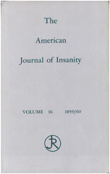Anorexia nervosa and anorexic-like syndromes in a population-based female twin sample
Abstract
OBJECTIVE: The authors explored the epidemiologic characteristics and risk factors of anorexia nervosa and examined the relationship between narrowly defined anorexia nervosa and anorexia-like syndromes. METHOD: Structured interviews were administered to a population-based sample of 2,163 female twins. Anorexia nervosa was diagnosed by computer algorithm ("computer narrow") and by narrow and broad clinical definitions. RESULTS: Lifetime prevalence estimates of 0.51%, 1.62%, and 3.70% were obtained for the computer narrow, clinical narrow, and clinical broad diagnoses, respectively. Dieting status, greater number of years of parental education, low self-esteem, high levels of neuroticism, and maternal overprotectiveness were significantly associated with anorexia nervosa. Both the pattern of comorbidity and the relationship to epidemiologic risk factors suggested an etiologic continuity between narrowly and broadly defined anorexic syndromes. Co- twins of twins with anorexia nervosa were at significantly higher risk for lifetime anorexia nervosa, bulimia nervosa, major depression, and current low body mass index. Significant comorbidity was found between anorexia nervosa and major depression, bulimia nervosa, generalized anxiety disorder, alcoholism, phobias, and panic disorder. CONCLUSIONS: The authors' analyses support the hypothesis of a spectrum of anorexic- like syndromes in women. These syndromes are familial and share familial etiologic factors with major depression and bulimia nervosa.
Access content
To read the fulltext, please use one of the options below to sign in or purchase access.- Personal login
- Institutional Login
- Sign in via OpenAthens
- Register for access
-
Please login/register if you wish to pair your device and check access availability.
Not a subscriber?
PsychiatryOnline subscription options offer access to the DSM-5 library, books, journals, CME, and patient resources. This all-in-one virtual library provides psychiatrists and mental health professionals with key resources for diagnosis, treatment, research, and professional development.
Need more help? PsychiatryOnline Customer Service may be reached by emailing [email protected] or by calling 800-368-5777 (in the U.S.) or 703-907-7322 (outside the U.S.).



